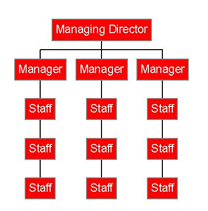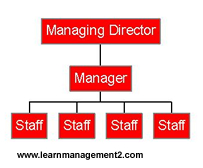For this session we focused on the area of organising. Last week we discussed planning and this is a follow on from this. Firstly we need to defined what organising actually is. According to Morley et al (2006) organising is the process of dividing and co-ordinating the tasks to be achieved within an organisation between the various groups, individuals and departments
It is essential that the organisational structure is flexible enough to allow the company to make changes to the structure when they need to.
When we speak about organising we need to discuss two important elements:
- The structure configuration
- Structural operation
Structure configuration- this refers to the shape and size of the organisation. There are a number of elements that need to be reviewed in relation to the firm's structure configuration. These are:
- Division of labour-this is the dividing up of job into small tasks and allocating those tasks to particular individuals.
- Spans of control-how many subordinates/employees is a manager responsible for? If tasks are complex managers tend to be in charge of a small number of employees (narrow spans of control). If tasks are routine then managers can be responsible for a larger number of employees (large spans of control).
- Hierarchical levels-is your organisation tall(lot of levels) or flat (very few levels)
Example of a flat structure
Example of a tall structure

- Departmentalisation-an organisation can adopt a number of forms of departmentalisation. These are:
(a) Functional departmentalisation 
(b) Product departmentalisation
(c) Geographical departmentalisation
(d) Customer departmentalisation
(e) Matrix departmentalisation
(f) Mixed departmentalisation
Structural operation
This focuses on the process and operations of the organisational structure. The issues that need to be considered are as follows:
- Formalisation-this is where the firm is ruled by rules and procedures
- Informal organisation-this often occurs in the canteen, where issues are discussed amongst staff. There is no structure to this.
Power
Managers are given power within the organisation. There are four types of power which are:
- Coercive power-the manager has the ability to use their power to punish employees
- Reward power-manager has the power to reward certain employees with bonuses, gift vouchers etc
- Legitimate power-this is the power of the position that the manager takes on when they are appointed manager to a particular position within the company
- Information power-this is power based on the information that the manager possess
What are the basic considerations in the design of and organsiational structure?
First of all the companh need to ensure that they have clear objectives and that these objectives are clearly communicated and understood by all. Secondly, what is the likely growth of the organisation. Does the organisation plan to launch new products or enter new markets? If so is there a set date or time for this to happen? Thirdly, have task and element functions been identified? What is the company's unique selling point, what is deemed valuable about the firm's products or services? Fourthly, what are the legal requirements that the firm needs to be aware of? Lastly, how is work going to be divided out in the organisation?
When designing the organisational structure the organsiation has to decide whether they will adopt a centralised or decentralised approach to decision making. A centralised approach is where decision making takes place among a few people in the organisation. It is high possible that these people will be located in the same location. If the company adopts a decentralised approach then decision making can be taken by a large number of people and in some cases in different branches or locations.

No comments:
Post a Comment